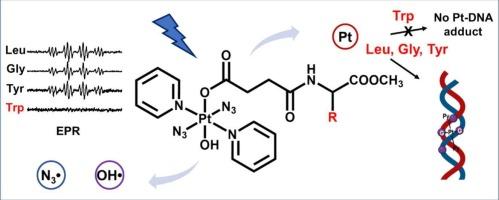Tuning the photoactivity of diazido Pt(IV) prodrugs with amino acid methyl esters
IF 3.2
2区 化学
Q2 BIOCHEMISTRY & MOLECULAR BIOLOGY
引用次数: 0
Abstract
Photoactive Pt(IV) complexes conjugated to amino acid methyl esters trans,trans,trans-[Pt(py)2(N3)2(OH)(succinate-amino acid methyl ester)] (amino acid = L-leucine (1), glycine (2), L-tyrosine (3) and L-tryptophan (4)) have been synthesised and characterised. Complexes 1–4 showed high dark stability, but were activated upon irradiation with blue light to generate azidyl and hydroxyl radicals and Pt(II) species. Interestingly, conjugated tryptophan in 4 quenched the formation of azidyl and hydroxyl radicals and Pt-guanosine 5′-monphosphate adducts, while the amino acids in complexes 1–3 showed no significant effects on the formation of their photoproducts. Improved photocytotoxicity but lower dark cellular Pt accumulation in A2780 human ovarian cancer cells were observed for 1–4, with 50 % inhibition of cell viability (IC50) values of 1.4–7.0 μM) compared with the parent complex FM-190 (trans, trans, trans-[Pt(py)2(N3)2(OH)2]). Significant enhancement in Pt accumulation for 3 and 4 after irradiation probably contributes to their promising photocytotoxicity, especially for the tryptophan-conjugated complex 4.

用氨基酸甲酯调节重氮多铂(IV)前药的光活性
合成并表征了光活性Pt(IV)配合物与氨基酸甲酯反式、反式、反式-[Pt(py)2(N3)2(OH)(琥珀酸-氨基酸甲酯)](氨基酸= l -亮氨酸(1)、甘氨酸(2)、l -酪氨酸(3)和l -色氨酸(4))共轭。配合物1-4具有较高的暗稳定性,但在蓝光照射下被激活,产生叠氮基、羟基自由基和Pt(II)物质。有趣的是,配合物4中的共轭色氨酸抑制了叠氮基自由基和羟基自由基以及鸟苷5 ' -单磷酸加合物的形成,而配合物1-3中的氨基酸对其光产物的形成没有显著影响。与母体配合物FM-190 (trans, trans, trans-[Pt(py)2(N3)2(OH)2])相比,A2780人卵巢癌细胞的光毒性得到改善,但暗细胞Pt积累降低,细胞活力(IC50)值为1.4-7.0 μM)抑制50%。辐照后,3和4的铂积累显著增加,这可能有助于它们具有良好的光细胞毒性,特别是对色氨酸共轭复合物4。
本文章由计算机程序翻译,如有差异,请以英文原文为准。
求助全文
约1分钟内获得全文
求助全文
来源期刊

Journal of Inorganic Biochemistry
生物-生化与分子生物学
CiteScore
7.00
自引率
10.30%
发文量
336
审稿时长
41 days
期刊介绍:
The Journal of Inorganic Biochemistry is an established international forum for research in all aspects of Biological Inorganic Chemistry. Original papers of a high scientific level are published in the form of Articles (full length papers), Short Communications, Focused Reviews and Bioinorganic Methods. Topics include: the chemistry, structure and function of metalloenzymes; the interaction of inorganic ions and molecules with proteins and nucleic acids; the synthesis and properties of coordination complexes of biological interest including both structural and functional model systems; the function of metal- containing systems in the regulation of gene expression; the role of metals in medicine; the application of spectroscopic methods to determine the structure of metallobiomolecules; the preparation and characterization of metal-based biomaterials; and related systems. The emphasis of the Journal is on the structure and mechanism of action of metallobiomolecules.
 求助内容:
求助内容: 应助结果提醒方式:
应助结果提醒方式:


